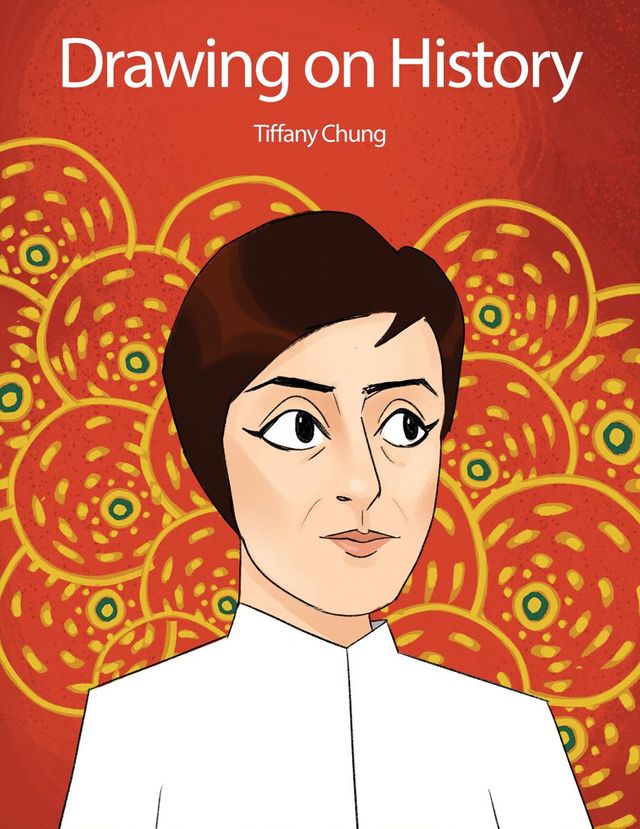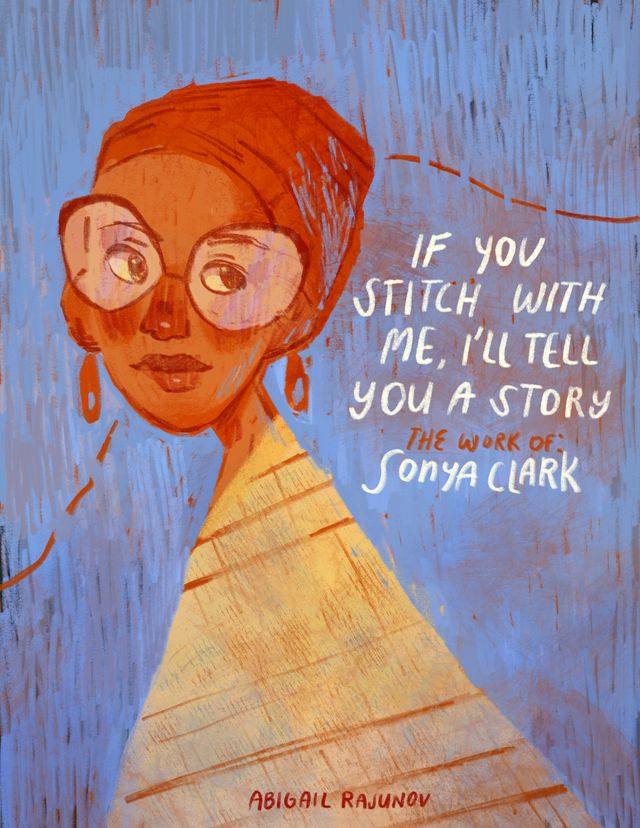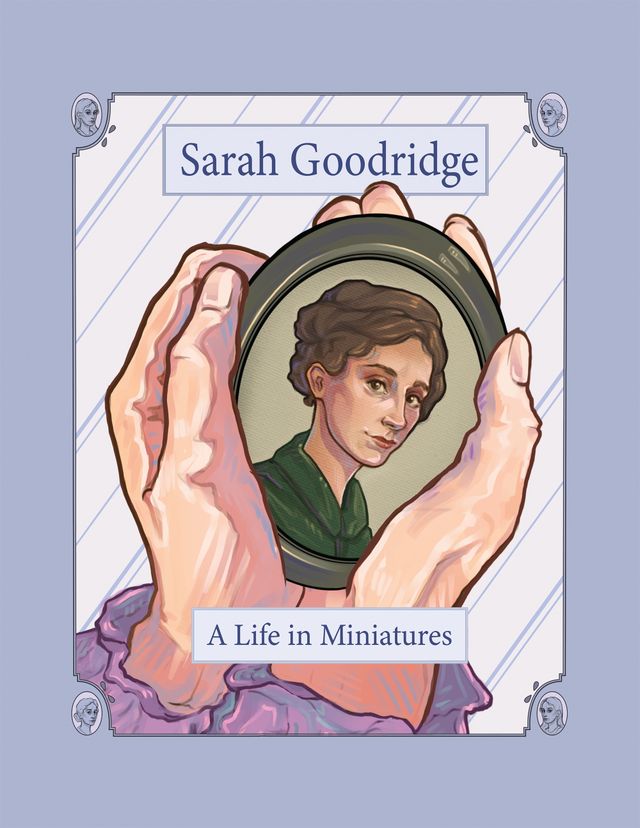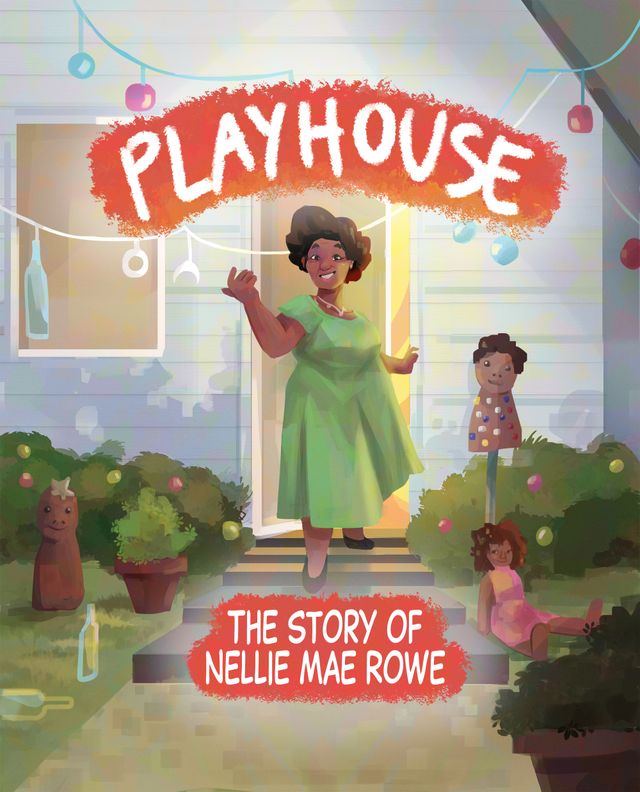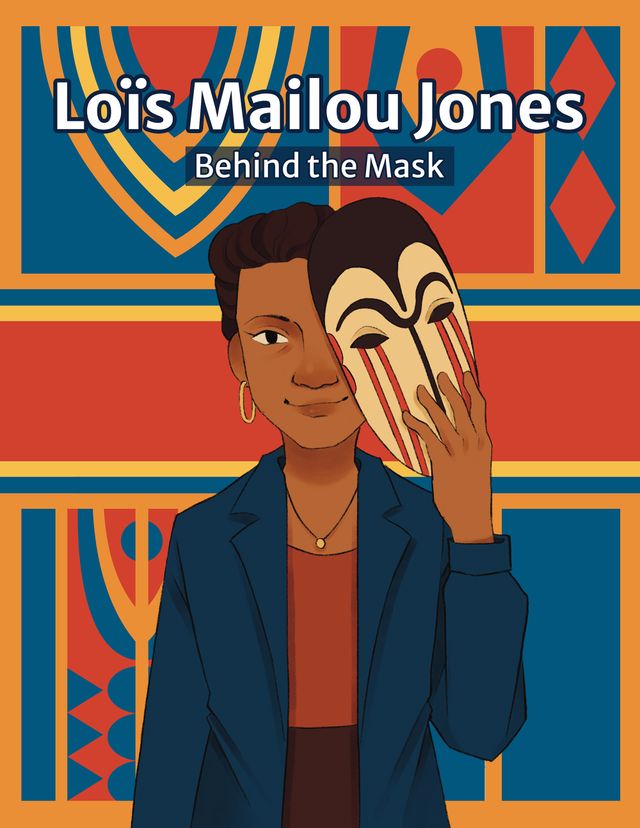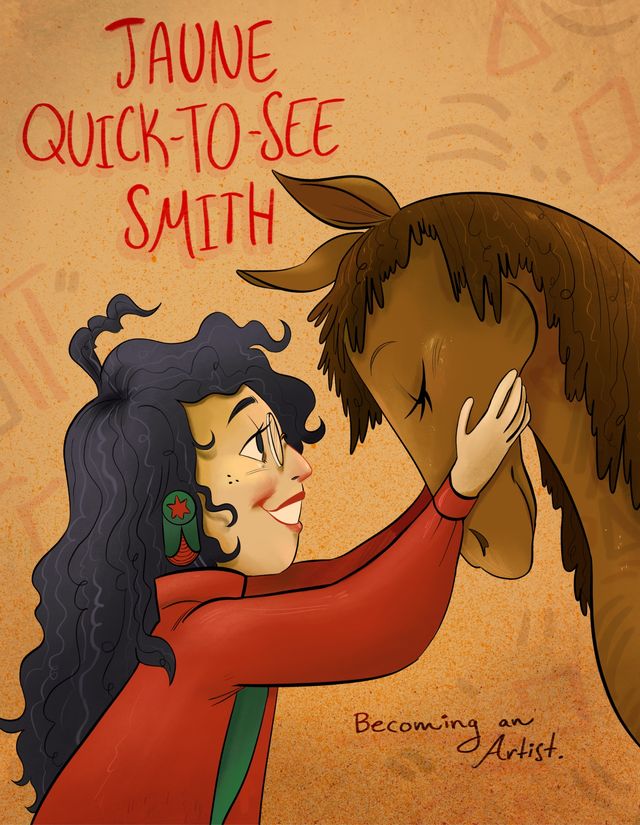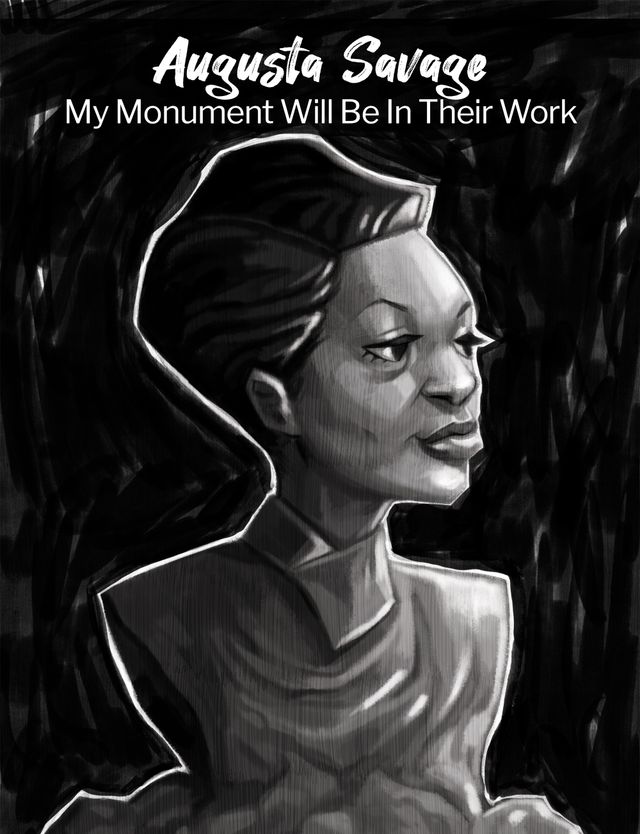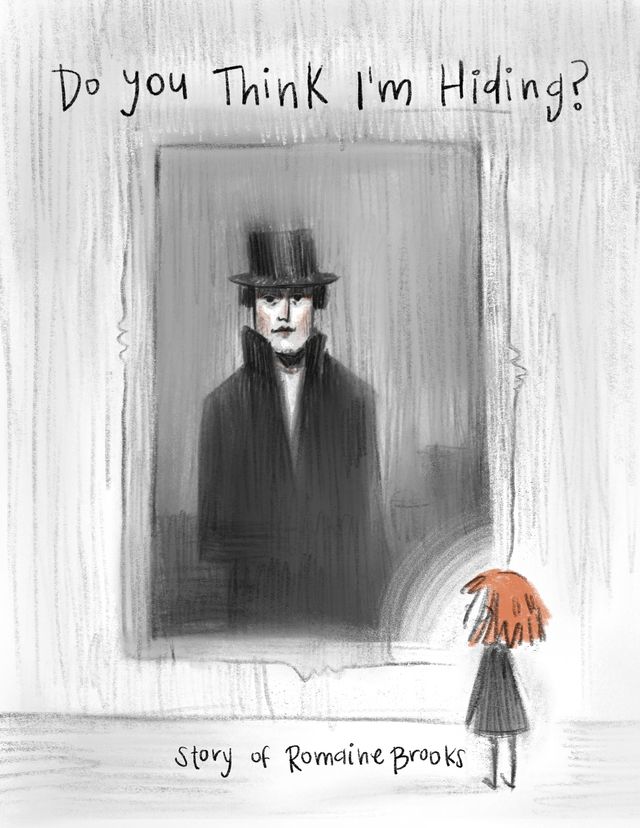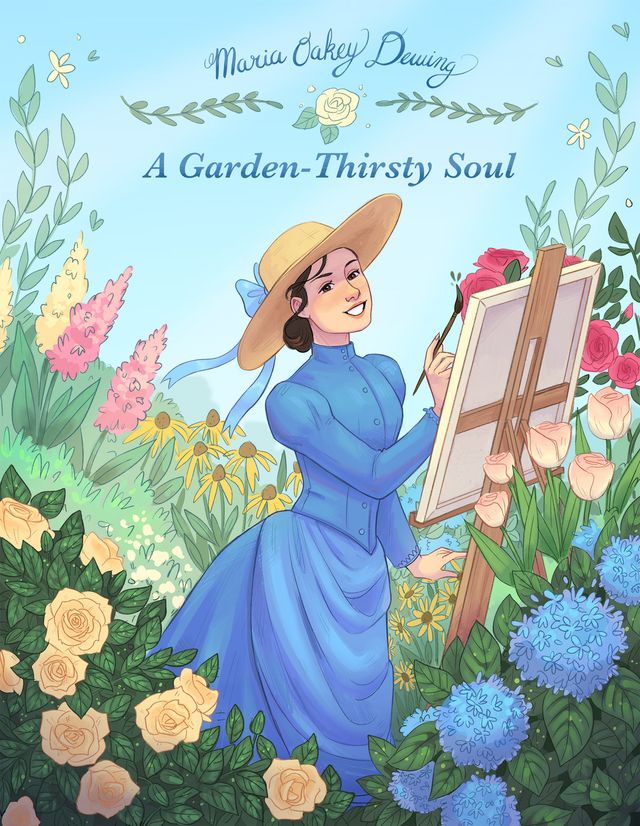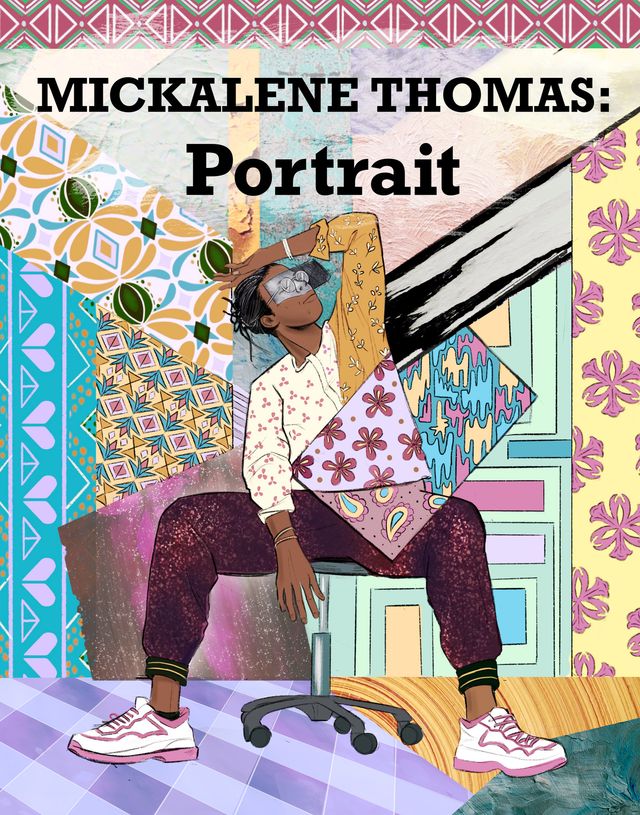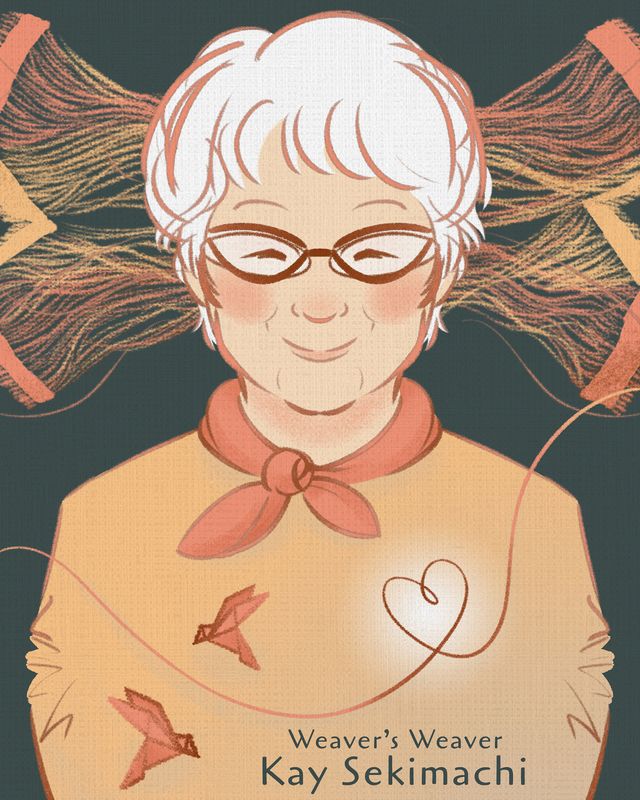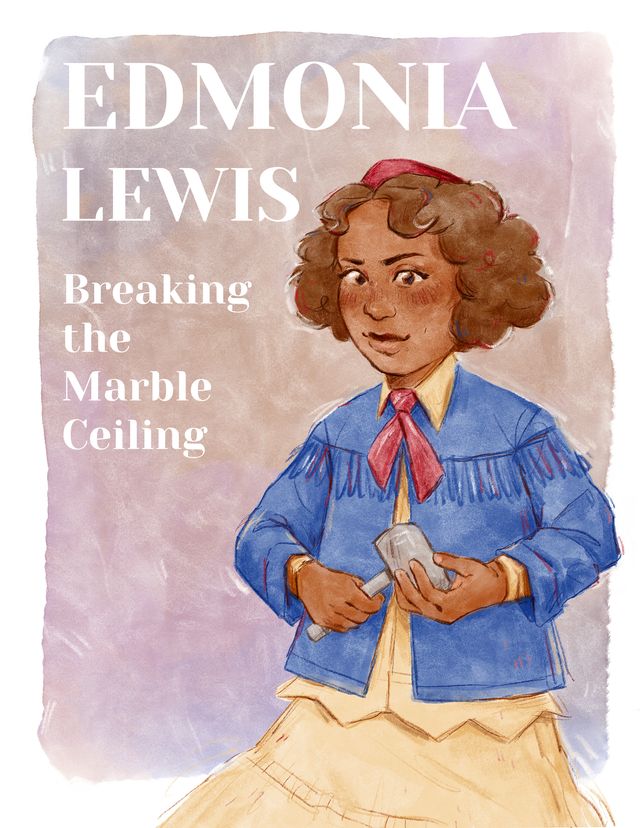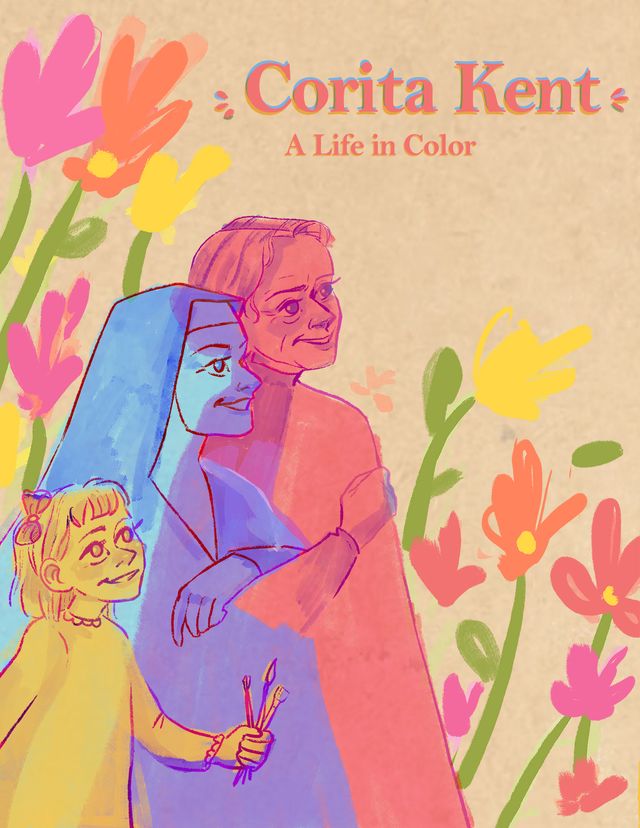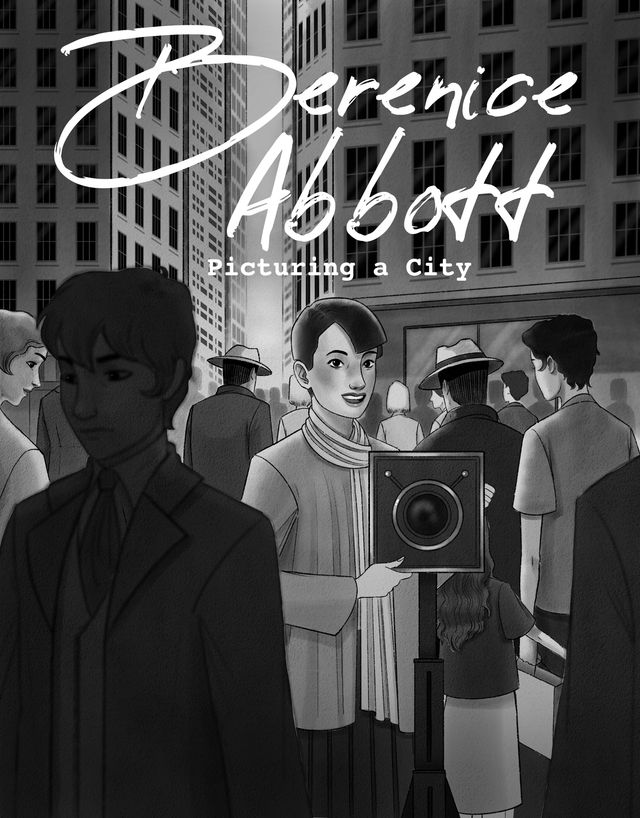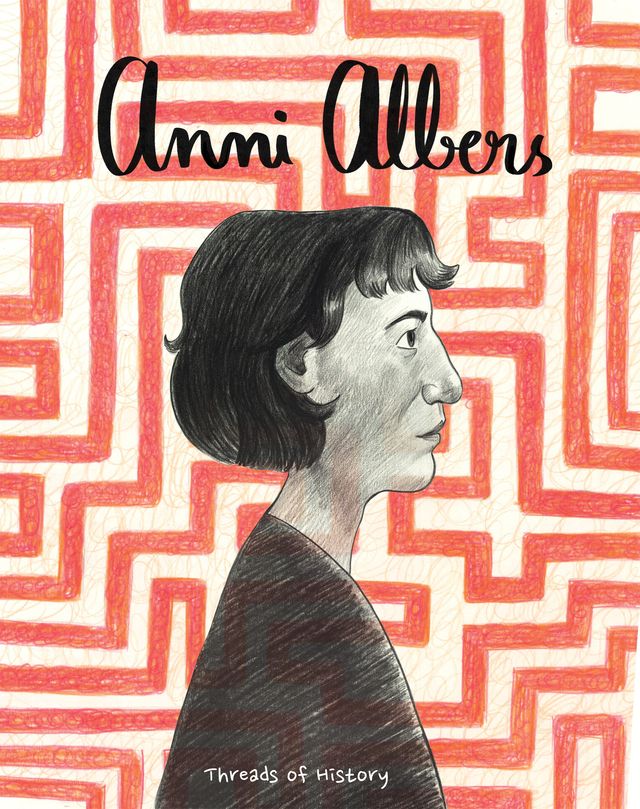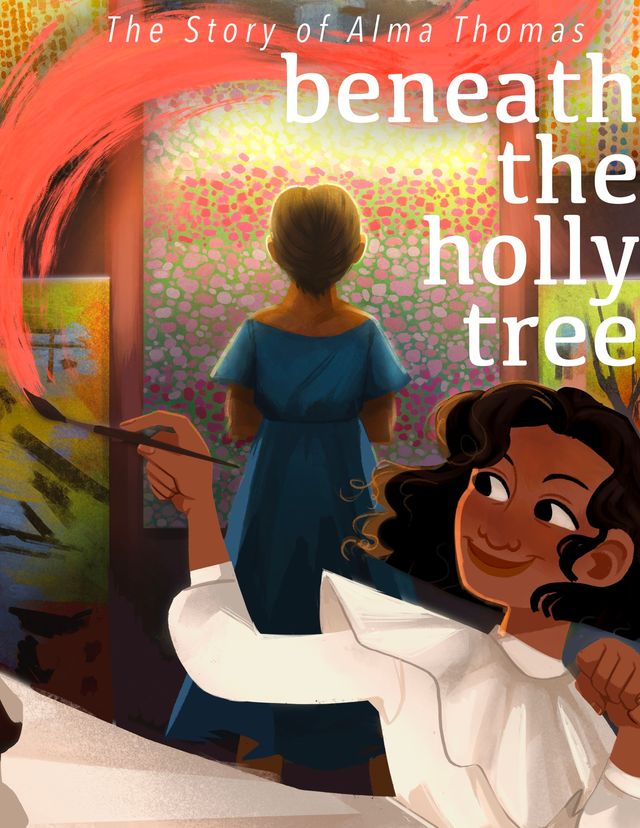An Overview
Sister Gertrude Morgan saw art as way to convey her faith and spread the Word of God. She was equal parts musician, painter, and poet, expressions that both energized and helped share her sanctified journey. She fascinated people for the “non-artist” ways of her artistry, and changed views on what it meant to be an artist, and what constituted a meaningful work of art.
This comic is part of a series Drawn to Art: Tales of Inspiring Women Artists that illuminates the stories of women artists in the collection of the Smithsonian American Art Museum. Inspired by graphic novels, these short takes on artists’ lives were each drawn by a student-illustrator from the Ringling College of Art and Design.
We invite you to read the comic and share it with your friends and young people in your life.
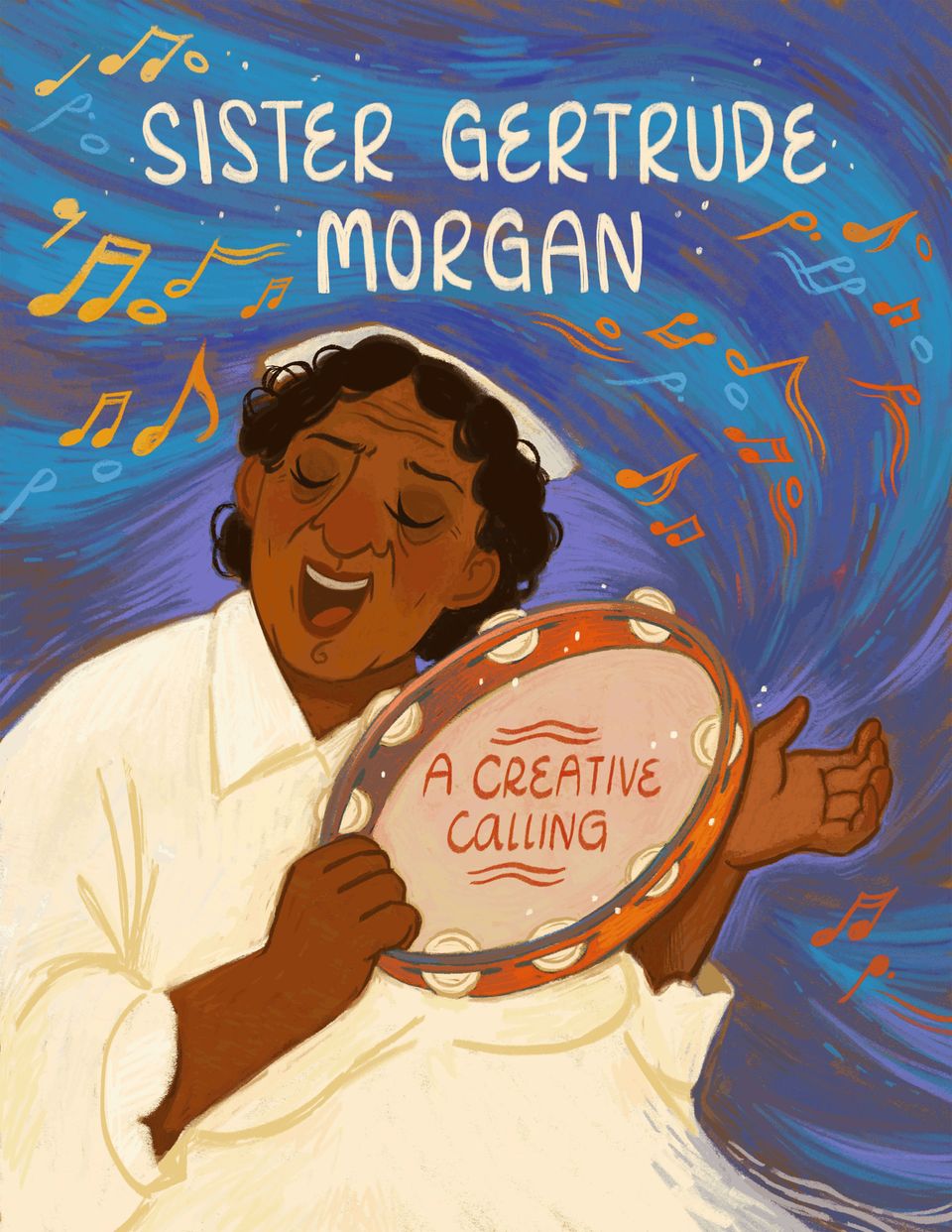
Cover
An older woman with a dark skin tone sits in the center-left of the page. She has short curly black hair and is wearing a white nurse's cap and white collared dress. She is singing with her mouth wide open, and her eyes closed while playing the tambourine, hitting it against her left hand. The tambourine has an orange shell with white jingles and a light pink head. Behind her is a sea of dark blue and aqua-striped waves, all emerging from behind her tambourine and traveling out toward the edges of the page. There are periwinkle and dark orange streaks and orange, light blue, and yellow musical notes floating throughout the waves. Above the figure "Sister Gertrude Morgan" is written in a white font. In the center of the tambourine in dark orange writing, with small wavy accent lines the text reads: "A Creative Calling."
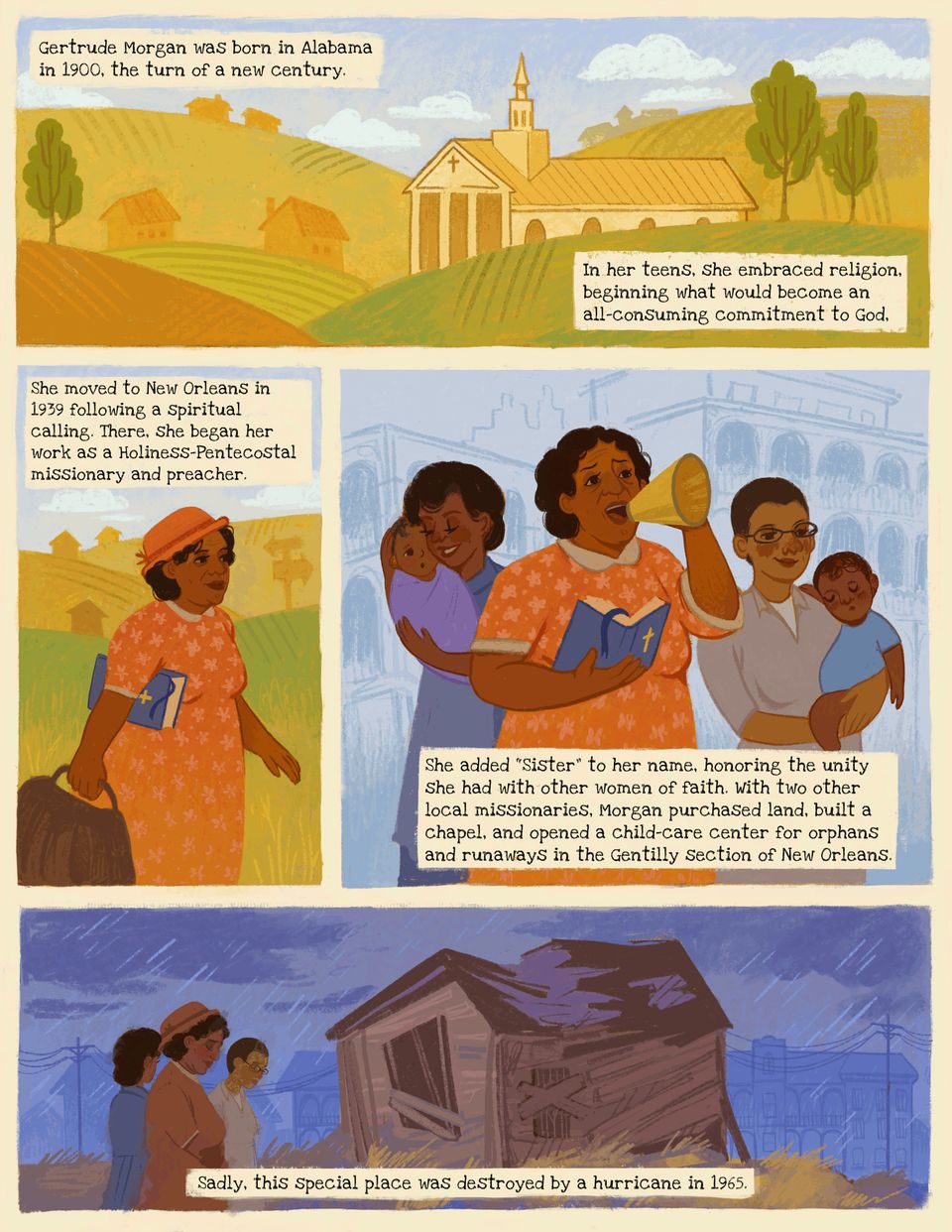
Page 1
Background: This page is broken into four distinct panels, one across the top third of the page, one in the middle left, one in the middle right, and one along the bottom third. The background behind the panels is a light beige. There are five text boxes of the same beige color, with black font.
Panel 1
A church appears out of the center of a scene of rolling hills. The church is a monotone light yellow and brown color, with a spire, a cross on the front, and large windows along the side. It is partially obscured by yellow-green and burnt orange hills rolling from the background into the foreground of the page. Orange silhouettes of small houses and olive-green trees are scattered across the landscape. Behind the landscape there is a light periwinkle sky with white fluffy clouds. A text box in the upper left corner reads: "Gertrude Morgan was born in Alabama in 1900, the turn of a new century." Another text box in the bottom right corner reads: "In her teens, she embraced religion, beginning what would become an all-consuming commitment to God."
Panel 2
A middle-aged woman, Sister Gertrude Morgan, with a dark skin tone and short curly black hair, is in the center walking to the right of the panel. She is wearing a coral hat and matching dress, with light coral floral details and a white collar. She is holding a dark brown bag in her right hand and has a large dark blue bible under her right arm. Behind her are green rolling hills with silhouettes of houses and arrow signs, and a light blue sky with white clouds. A text box at the top of the panel reads: "She moved to New Orleans in 1939 following a spiritual calling. There she began her work as a Holiness-Pentecostal missionary and preacher."
Panel 3
On a light blue background there are medium blue outlines of tall buildings in a Creole architectural style drawn in medium blue. In front of this there are three women and two small children standing in a group. On the left is a woman with a dark skin tone and short brown hair wearing a dark blue periwinkle dress with a light periwinkle apron. She has her eyes closed and is smiling, holding a baby up to right shoulder. The baby has a dark skin tone and dark short hair and is wrapped in a light purple cloth. In the center, Sister Gertrude stands wearing the same coral dress with light coral floral print and a white collar and sleeve details. She is holding a gold bullhorn up to her mouth with her left hand and is holding an open blue bible with her right hand. She is looking up to the right, shouting into the bullhorn. To her right is another young woman holding a child. She has a medium skin tone and very short brown hair, is wearing black rimmed glasses and a light gray collared dress with a white undershirt. She is holding a small child with a dark skin tone and short brown hair up on her left hip. The child is wearing a blue short-sleeved onesie and is asleep on the woman's left shoulder. A text box at the bottom of the page reads: "She added ‘Sister’ to her name, honoring the unity she had with other women of faith. With two other local missionaries, Morgan purchased land, built a chapel, and opened a child-care center for orphans and runaways in the Gentilly section of New Orleans."
Panel 4
In the center of the panel there is a run-down, broken wooden house sitting on a mound of dead yellow grass. The windows are boarded up and falling apart. Behind the house is a dark blue stormy sky with light rain falling from dark purple clouds. There is a dark blue outline of buildings and electrical posts in the back. The three women from panel three, including Sister Gertrude, stand in the left-and corner with their heads down, facing the broken house. A text box at the bottom reads: "Sadly, this special place was destroyed by a hurricane in 1965."
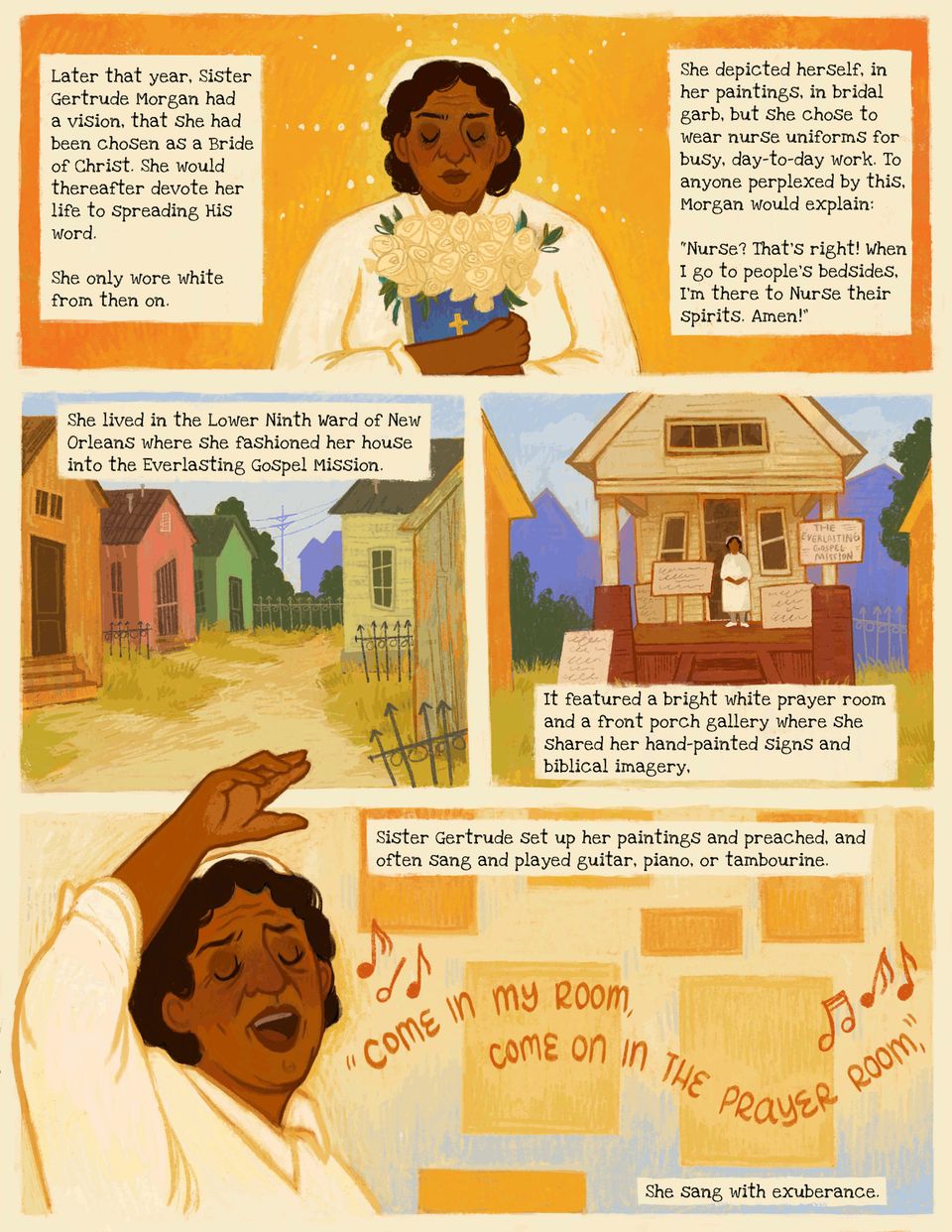
Page 2
Background: This page is made up of four distinct panels, sitting on a light beige background. There is one panel in the upper third, one in the middle left, one in the middle right, and one on the bottom third. There are six beige text boxes with black font.
Panel 1
An older Sister Gertrude stands in the middle of the panel with short curly black hair wearing a white cap and white collared long-sleeve dress. She has her eyes closed and is holding a blue bible up to her chest, clutched between her hands. A bunch of white roses emerge from the top of the bible. Lines of white dots fan out from behind her, fading into a yellow-orange background. The background is lighter yellow behind Sister Gertrude and gets darker toward the edges of the panel. A text box at the left reads: "Later that year, Sister Gertrude Morgan had a vision, that she had been chose as a Bride of Christ. She would thereafter devote her life to spreading His word. She only wore white from then on." A second text box to the right of the panel reads: "She depicted herself, in her paintings, in bridal garb, but she chose to wear nurse uniforms for busy day-to-day work. To anyone perplexed by this Morgan would explain: 'Nurse? That's right! When I got to people's bedsides, I'm there to Nurse their spirits. Amen!'"
Panel 2
A light beige road leads its way through a neighborhood of multicolored houses. Around each house is light yellow and green grass, growing between the small beige pathways leading from the road to the doors of the houses. An orange, bright coral, and bright green house, each with a dark roof, sits in a row on the left side of the road. On the right side is a gray and orange and a light lime green house, both also with dark roofs. There are black wrought iron fences around the houses, and each has dark windows and doors. In the background is a light blue sky and a dark blue silhouette of power lines and other houses. A text box at the top of the panel reads: "She lived in the Lower Ninth Ward of New Orleans where she fashioned her house into the Everlasting Gospel Mission."
Panel 3
A simple beige wooden house sits in the middle of the panel. It has a dark wood and brick front porch where Sister Gertrude stands wearing her white nurse uniform, clasping her hands in front of her. She stands in front of a dark doorway, with a window on either side. Above her is the second-floor overhang, with a long window running along it. The right wooden front post of her house has a white sign hung on it. There are three other large white signs surrounding Sister Gertrude. Behind her house are dark blue silhouettes of other houses. Her house sits between two orange building outlines and rests in a patch of light lime green grass. A text box at the bottom of the panel reads: "It featured a bright white prayer room and a front porch gallery where she shared her hand-painted signs and biblical imagery."
Panel 4
An older Sister Gertrude stands at the left side of the panel, singing. She is wearing her white nurse uniform and has short curly black hair. Her right arm gestures above her head, overlapping with the edge of the panel while her eyes are closed and her mouth is open wide. Behind her and to her right is a light-yellow wall that fades into a light blue color at the bottom. Yellow and orange rectangles of various sizes are hung on the wall. In orange text surrounded by orange musical notes "Come in my room, come on in the prayer room," is written floating out from Sister Gertrude's mouth. A text box at the top of the panel reads: "Sister Gertrude set up her paintings and preached, and often sang and played guitar, piano, or tambourine." A text box at the bottom of the panel reads: "She sang with exuberance."
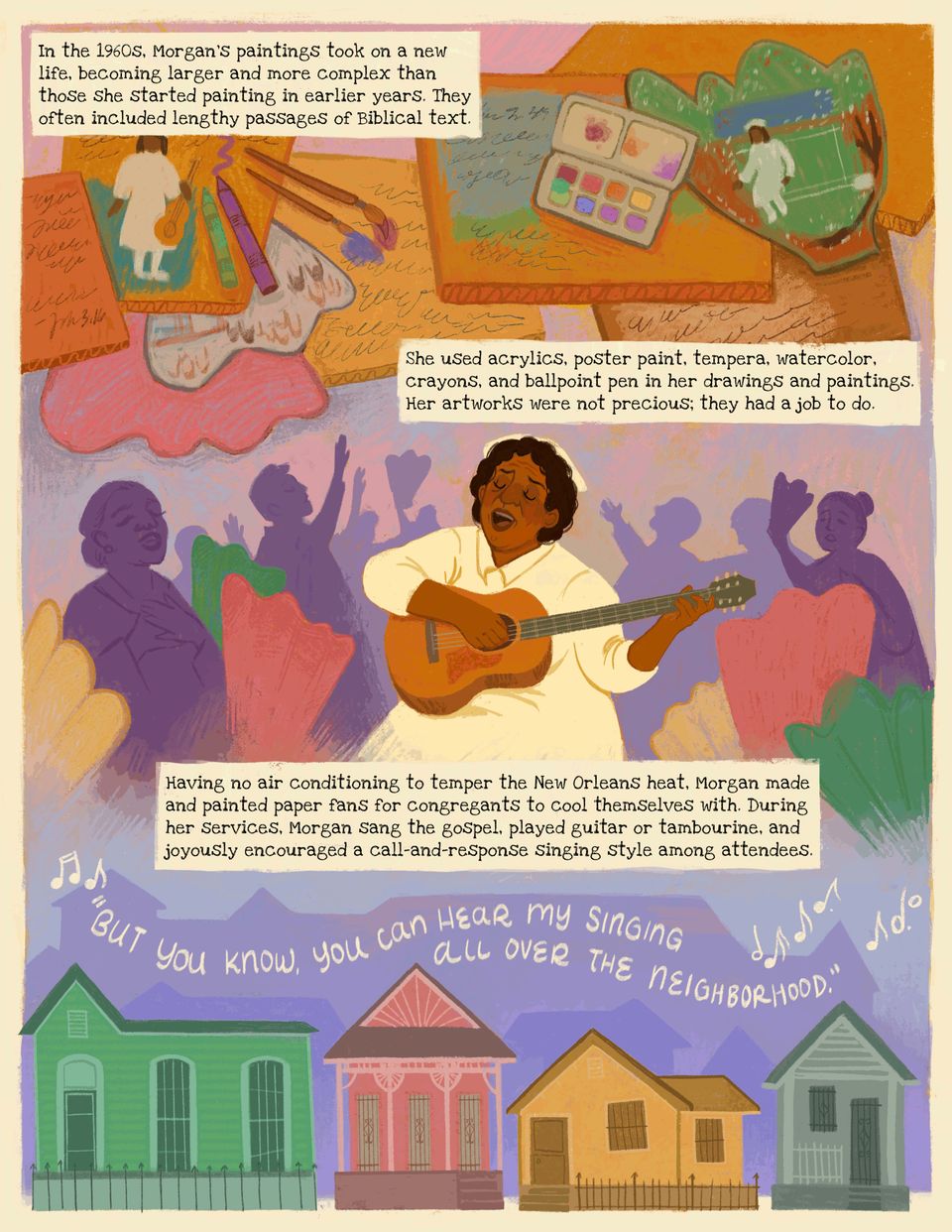
Page 3
Background: This page is made up of three panels, blurred together at the edges. One is at the top, one in the middle, and one on the bottom of the page. They all sit against a light purple and periwinkle gradient, with a light beige border. There are three beige text boxes with black text.
Panel 1
Overlapping pieces of orange cardboard with paint and writing on them lay on a light purple backdrop. Drawn on the posters are images of Sister Gertrude in her white nurse's uniform. There are also painted cut-out wavy paper fans laying among the posters. A watercolor palette rests on top of the pile, as well as purple and green crayons and two paint brushes. A text box in the top left reads: "In the 1960s, Morgan’s paintings took on a new life, becoming larger and more complex than those she started painting in earlier years. They often included lengthy passages of Biblical text." A second text box in the bottom right reads: "She used acrylics, poster paint, tempera, watercolor, crayons, and ballpoint pen in her drawings and paintings. Her artworks were not precious; they had a job to do."
Panel 2
A large crowd of people in purple silhouettes stand around Sister Gertrude. They are singing and gesturing their arms in the air, some waving fans, with their eyes closed. The people in the foreground are dark purple, and fade into lighter purple in the background. Brightly colored yellow, pink, and green fans pop up out of the bottom corners. Sister Gertrude sits in the center wearing her white nurse’s uniform. She is singing with her eyes closed and is playing a light brown acoustic guitar. A text box at the bottom of the panel reads: "Having no air conditioning to temper the New Orleans heat, Morgan made and painted paper fans for congregants to cool themselves with. During her services, Morgan sang the gospel, played guitar or tambourine, and joyously encouraged a call-and-respond singing style among attendees."
Panel 3
A row of colorful houses sits against a gradient of purple building silhouettes. On the left is a clover green house with a wrought iron fence and large arched windows. To the right is a bright purple house with ornate light purple columns and a tall brick porch. Next to that is a short mustard house with a wooden front door and light brown roof, with a wrought iron fence around it. Farthest to the right edge is a thin teal-gray house with a small porch and a dark window and door with iron bars running vertically across them. White text with white musical notes float across the top of the panel reading "'But you know, you can hear my singing all over the neighborhood.'"
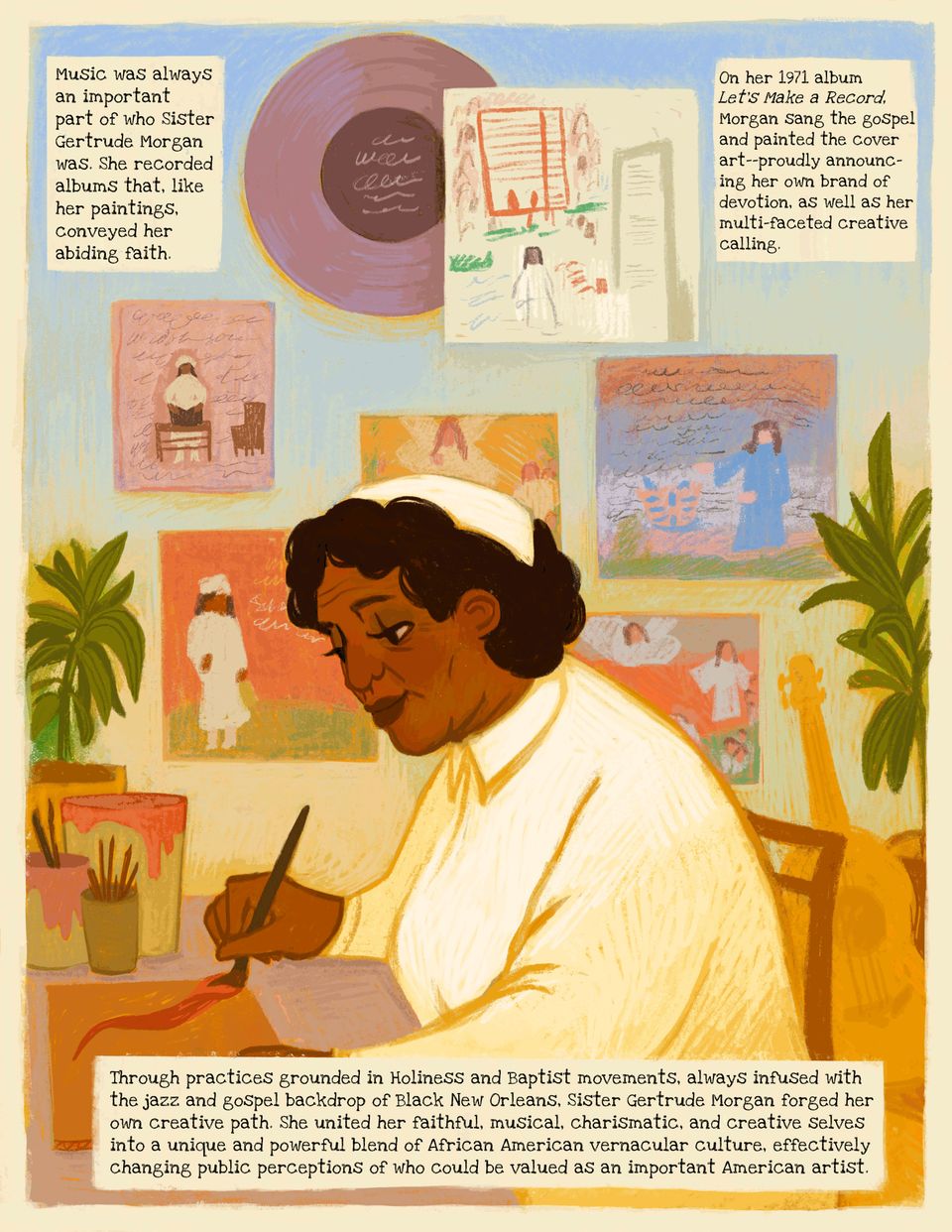
Page 4
Background: This page is one large illustration with a beige border. There are three beige text boxes with black text.
Sister Gertrude sits at a desk facing the left side of the page with her head down, painting. She is wearing her white nurse's uniform and is sitting in a wooden chair. She is painting with red paint, her right hand holding the brush, and her left resting on the cardboard poster she's decorating. On the other side of her desk there are cans of pink paint with brushes in them and a green leafy plant sitting in a yellow pot. On the right-hand corner of the room is another larger green leafy plant and her yellow guitar leaning against the wall. The wall behind her fades from a light blue at the top into a light yellow at the bottom. Her artwork adorns the wall, a purple record with a white illustrated album cover for her album Let's Make a Record hangs at the top. Five of her other artworks hang underneath covering the wall. A text box in the upper left corner reads: "Music was always an important part of who Sister Gertrude was. She recorded albums that, like her paintings, conveyed her abiding faith." A text box in the upper right reads: "On her 1971 album Let’s Make a Record, Morgan sang the gospel and painted the cover - proudly announcing her own brand of devotion, as well as her multi-faceted creative calling." A text box at the bottom of the page reads: "Through practices grounded in Holiness and Baptist movements, always infused with the jazz and gospel backdrop of Black New Orleans, Sister Gertrude Morgan forged her own creative path. She united her faithful, musical, charismatic, and creative selves into a unique and powerful blend of African American vernacular culture, effectively changing public perceptions of who could be valued as an important American artist."

End page
The background is a gradient from yellow to dark orange, with brush strokes arching around the central image. In the middle of the page is a red tambourine shell with silver jingles. Sitting in the middle of the tambourine shell is a bouquet of white roses with dark green stems. A few white petals fall off the flowers, flowing to the bottom left corner of the page. White text at the bottom of the page reads: "Illustrated by Stephanie Hunton."














